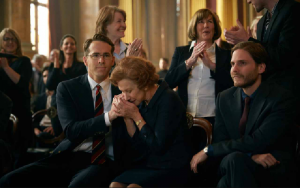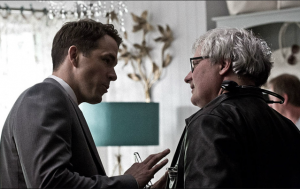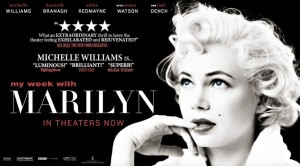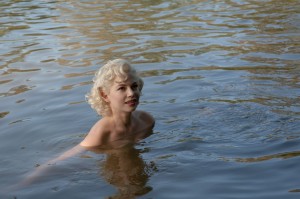RICHARD’S WEEKEND MOVIE REVIEWS FROM CP24! THURSDAY APRIL 2, 2015.
 Richard’s CP24 reviews for “Furious 7,” “Woman in Gold” and “While We’re Young” with anchor Farah Nasser.
Richard’s CP24 reviews for “Furious 7,” “Woman in Gold” and “While We’re Young” with anchor Farah Nasser.
Watch the whole thing HERE!
 Richard’s CP24 reviews for “Furious 7,” “Woman in Gold” and “While We’re Young” with anchor Farah Nasser.
Richard’s CP24 reviews for “Furious 7,” “Woman in Gold” and “While We’re Young” with anchor Farah Nasser.
Watch the whole thing HERE!
 Richard’s “Canada AM” reviews for “Furious 7,” “Woman in Gold” and “While We’re Young.”
Richard’s “Canada AM” reviews for “Furious 7,” “Woman in Gold” and “While We’re Young.”
Watch the whole thing HERE!
 You get a lot of movie for your dollar in “Woman in Gold.” Two movies in fact.
You get a lot of movie for your dollar in “Woman in Gold.” Two movies in fact.
The framing device is the true story of Maria Altmann (Helen Mirren), an Austrian Holocaust survivor who enlists the help of young lawyer Randol Schoenberg (Ryan Reynolds) to help her reclaim five Gustav Klimt paintings, including one of her aunt, Portrait of Adele Bloch-Bauer I. Looted by Nazis at the outset of WWII the iconic artwork—it’s referred to as the “Mona Lisa of Austria” in the film—had hung in the state gallery for five decades. The years-long case wound its way slowly through the courts until it reached the Supreme Court of the United States and then binding arbitration by a panel of three Austrian judges.
Running parallel is the harrowing story of the Bloch-Bauer and Altmanns, rich Jewish families torn apart by the Nazi occupation of Austria. Young Maria (Tatiana Maslany) is a beautiful new bride forced to leave her mother, father and extended family and make the dangerous journey to a new life in to America to avoid the concentration camps.
It’s two thrillers, one legal, one humanistic, mixed and matched to form a whole but “Woman in Gold” isn’t strictly a movie about a lawsuit or Holocaust horror, it’s really a story about the power of memories and heritage.
Despite frequent flashbacks director Simon “My Week with Marilyn” Curtis delivers a straightforward retelling of this true story. Occasionally it feels a tad too straightforward but Mirren gives Maria a wistful, powerful spirit that provides the emotional underpinning to propel the stories forward. It is the sometimes pained, sometimes joyful looks that cross her face as she remembers her long gone family that makes the story compelling, not the legalese or Reynolds’s lawyer character. On Mirren’s face is the story, a vision of loss and anguish, but tempered with a tale of determination.
As a thriller “Woman in Gold” occasionally feels conventional but the performance of its lead actress is anything but.
 Woman in Gold is director Simon Curtis’s follow up to the Academy Award nominated film My Week with Marilyn. His first feature chronicled seven days in the life of Marilyn Monroe during the production of the 1957 film The Prince and the Showgirl.
Woman in Gold is director Simon Curtis’s follow up to the Academy Award nominated film My Week with Marilyn. His first feature chronicled seven days in the life of Marilyn Monroe during the production of the 1957 film The Prince and the Showgirl.
In the new movie Dame Helen Mirren plays Maria Altmann, an Austrian Holocaust survivor who enlists the help of young lawyer Randol Schoenberg (Ryan Reynolds) to help reclaim five Gustav Klimt paintings, including one of her aunt, Portrait of Adele Bloch-Bauer I. Looted by Nazis at the outset of WWII the iconic artwork—it’s referred to as the “Mona Lisa of Austria” in the film—had hung in the state gallery for five decades. The years-long case wound its way slowly through the courts until it reached the Supreme Court of the United States and then binding arbitration by a panel of three Austrian judges.
He spent a week with Marilyn, the director teases, but years with Maria.
Altmann’s story first grabbed his interest when he saw a BBC Imagine documentary on her struggle to reclaim the artworks that were rightfully hers. He was taken with the character of Maria, who reminded him of many people he grew up with. “I’m from a Jewish family in London,” he says, “and I met many women like Maria.”
The resulting film plays like two thrillers, the present day legal story and the backstory, told in flashbacks.
One is a procedural, one a horrifying look at the rise of Nazism in Austria, mixed and matched to form a whole but “Woman in Gold” isn’t strictly a movie about a lawsuit or Holocaust horror, it’s really a story about the power of memories and heritage.
Curtis says the casting of Mirren was crucial to the success of the film. He needed an actress of a certain age and one who could portray the emotional range of a woman trapped between her real world pain and the memories she holds dear. On Mirren’s face is the story, a vision of loss and anguish, but tempered with a tale of determination.
Curtis first met Mirren almost thirty years ago when he assistant directed a production of Measure for Measure in 1979. He remembers her as a formidable force and jokingly calls himself “her tea boy.”
“I sat with her in the kitchen and helped her answer fan mail and boiled water for tea,” he says. “I did essentially the same job on this film.”
 The Oscar battle of the biopics is in full swing with the release of “My Week with Marilyn.” Michelle Williams hands in exactly the kind of performance the Academy loves. As Marilyn Monroe she turns the camera on Hollywood, playing one of its biggest stars at the peak of her career.
The Oscar battle of the biopics is in full swing with the release of “My Week with Marilyn.” Michelle Williams hands in exactly the kind of performance the Academy loves. As Marilyn Monroe she turns the camera on Hollywood, playing one of its biggest stars at the peak of her career.
Based on two books by Colin Clark, “The Prince, The Showgirl and Me” and “My Week with Marilyn,” the movie’s main character isn’t Munroe, but Clark (Eddie Redmayne), the third assistant director on “The Prince and the Showgirl” starring Sir Laurence Olivier (Kenneth Branagh) and Munroe. It was the summer of 1956 and Clark was a twenty-three-year-old, who, like the rest of the planet, was smitten with Monroe. The two form a bond, and for a few days it looks like his love for her might actually be reciprocated. Perhaps this should have been titled “The Week I Almost Made It with Marilyn.”
Everyone has been predicting Oscar success for Williams and rightly so, she’s very good, but the bulk of the movie is carried by Redmayne. It is his coming of age story that really fuels the movie’s dramatic arc and his youthful excitement at meeting and, possibly mating with, the movie star is infectious. Of course he’s playing against Williams and Branagh in much showier roles, so I suspect he’ll get the sort shrift attention wise.
As for the above the title stars, Branagh shows two sides to Olivier, the flamboyantly theatrical public persona contrasted against his testy frustration of having to work overshadowed the unprofessional movie star from America. “She’s all instinct, no craft,” he says.
Branagh is very good, but when placed against Williams’s Monroe his work seems to lack the soul she brings to every frame of film. He does have many of the film’s best lines, however. His delivery of lines like, “Trying to teach Marilyn to act is like teaching Urdu to a badger,” is letter perfect and adds much to the movie.
Even almost fifty years after her death Monroe is still one of the best-known actresses in the world. Her famous face adorns everything from wine bottles to Volkswagen commercials, and yet Williams manages to bring something new to someone we thought we knew so well. Her off-screen life, as dramatic as anything she ever did on screen, is tenderly portrayed here but the story isn’t as interesting as the performance.
Williams plays Monroe as a coddled woman-child, crippled by nerves, insecurity, but long on instinct but she goes beyond the little girl lost act so often associated with Monroe. She digs deep, cleaving the role into two parts—the sex-bomb and the vulnerable real life counterpart.
“Shall I be her?” she asks Colin as a crowd descends on them in public. She then shifts effortlessly from the private to the public Marilyn, blowing kisses and turning the flirt up to eleven. But when she is behind closed doors the performance glows. While some of the dialogue is a bit too Psyche 101—“Why do the people I love always leave me?” she pouts at one point—the complexity behind her eyes isn’t.
Williams has perfected playing dour characters in movies like “Blue Valentine,”—so it is a bit of a revelation to see her smile here—but this is something else—well rounded and revelatory.
“My Week with Marilyn” feels a little old-fashioned. The show biz story about, as they say in the film, “a great actor who wants to be a movie star and a movie star who wants to be a great actor,” is overtly theatrical, but Williams brings real soul and heart, handing in the Oscar worthy performance that eluded Monroe in real life.
 SYNOPSIS: Based on two books by Colin Clark, The Prince, The Showgirl and Me and My Week with Marilyn, the movie’s main character isn’t Monroe, but Clark (Eddie Redmayne), the third assistant director on The Prince and the Showgirl starring Sir Laurence Olivier (Kenneth Branagh) and Monroe. It was the summer of 1956 and Clark was a 23-year-old who, like the rest of the planet, was smitten with Monroe. The two form a bond, and for a few days it looks like his love for her might actually be reciprocated.
SYNOPSIS: Based on two books by Colin Clark, The Prince, The Showgirl and Me and My Week with Marilyn, the movie’s main character isn’t Monroe, but Clark (Eddie Redmayne), the third assistant director on The Prince and the Showgirl starring Sir Laurence Olivier (Kenneth Branagh) and Monroe. It was the summer of 1956 and Clark was a 23-year-old who, like the rest of the planet, was smitten with Monroe. The two form a bond, and for a few days it looks like his love for her might actually be reciprocated.
Ratings:
Richard: ***1⁄2
Mark: ***
Richard: Mark, almost 50 years after her death, Marilyn Monroe is still one of the best-known actresses in the world and yet Michelle Williams manages to bring something new to someone we thought we knew so well. Even though I liked this movie and thought that Monroe’s off-screen life, as dramatic as anything she ever did on screen, is tenderly portrayed, the story isn’t as interesting as the performance. What did you think?
Mark: This movie is definitely NOT the Marilyn Monroe biopic. It’s a small, charming film about the havoc the sexiest woman in the world can have on those around her. The movie’s fabulous first half sets up the characters, milieu, and conflicts, but then doesn’t have anywhere to go. So the story is weak, as you say, but its pleasures are in the fine details, including Michelle Williams’ amazing portrayal of Ms. Monroe, and the wonderful sense of time and place on a film set circa 1956. And I’ve never seen Kenneth Branagh better!
RC: Branagh is very good, but when placed against Williams’s Monroe his work seems to lack the soul she brings to every frame of film. He does have many of the film’s best lines, however. His delivery of lines like, “Trying to teach Marilyn to act is like teaching Urdu to a badger,” is letter perfect and adds much to the movie but I think the Oscar nomination here will go to Williams.
MB: The movie belongs to her, no question. But there are so many finely etched smaller parts that flesh out the movie. Judi Dench as the regal Dame Sybil Thorndike and Zoe Wanamaker as prickly acting coach Paula Strasberg are both exceptional. But why was the Arthur Miller part so underwritten? And were you impressed by Eddie Redmayne as the boy who becomes a man?
RC: His story should have been titled The Week I Almost Made It with Marilyn. It might have spiced up his role a bit. He’s good, I think, but when Williams and Branagh are on screen he disappears. He’s a main character but unfortunately for him he’s saddled with a quiet role in a movie filled with bravura performances.
MB: I thought the movie was quite funny in places, by the way; the clash of acting styles between the Brits and the Yanks made for good fun, as did Branagh’s growing exasperation with his star. But the abrupt turnaround at the end of the movie where he gushes over Marilyn’s “natural, intuitive talent” seemed forced and false.